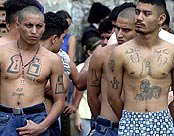 Next month a new locally-produced reality TV show will air in Guatemala. Partly funded by the USAID office in which V's sister-in-law works, it will show how a group of ten former mareros (gang-members) cope with living together for two weeks while volunteers from civil society venture in to teach them basic skills in accounting, customer service, human resources, sales, personal motivation and marketing.
Next month a new locally-produced reality TV show will air in Guatemala. Partly funded by the USAID office in which V's sister-in-law works, it will show how a group of ten former mareros (gang-members) cope with living together for two weeks while volunteers from civil society venture in to teach them basic skills in accounting, customer service, human resources, sales, personal motivation and marketing.The end result is said to be two new small businesses: a car wash and a shoe repair shop. Yet if these ventures end up going tetas arriba, the group will surely have improved their chances of being head-hunted by the kingpins of organised crime.
In Guatemala there are approximately 14,000 active mareros belonging to over 400 distinct groups. The most organised maras, such as MS-13 or Salvatrucha evolved in the Hispanic gangland/penitentiary culture of LA, exported back to Central America in the early 90s at the conclusion of the Cold War when the gringos deported numerous clicas (cells) back to their countries of origin.
The maras are a fully transnational phenomenon: MS-13 has some 20,000 members in the US and 4000 in Canada, out of a total of around 100,000 across the hemisphere. Their most common group activities are extortion and drug trafficking. The more sophisticated provide surrogate goverment in areas where state authority is patchy.
Recently the mareros have found themselves on the end of an extra-judicial backlash. There were 5,330 violent deaths in Guatemala during 2005, a figure that includes many males in their teens or early twenties who fell victim not to rival gangs, but to vigilantes with a mind to cull the maras infesting their communities.
A total of 90 people have died violently in the first week of February, 17 last Monday alone, when most of the corpses bore signs of torture and written messages alleging membership of one of the maras.

No comments:
Post a Comment